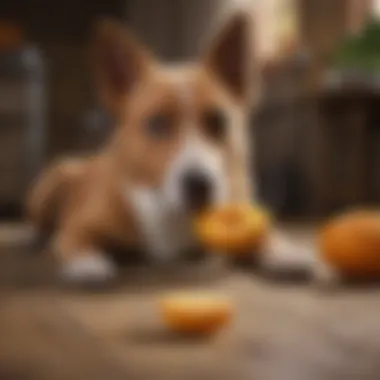Can Dogs Safely Eat Squash? A Nutrition Guide


Intro
When considering those furry bundles of joy that bound into our lives and hearts, the question of what they can and cannot eat comes to the forefront. As devoted pet owners, many might wonder about the suitability of various foods, including vegetables like squash. After all, what could be more delightful than including a nutritious treat in our dog’s diet? This article delves into the ins and outs of feeding squash to dogs, dissecting the nutritional benefits, potential risks, preparation methods, and serving sizes necessary for canine enjoyment.
Understanding Squash
Before diving into whether dogs can eat squash, one must understand what squash is comprised of. Squash falls into several categories—such as summer and winter varieties—all of which have distinct nutritional profiles and culinary applications. For example, zucchini and yellow squash fall under the summer category, while butternut and acorn squash belong to winter. Each has its own flavors and textures, which can enrich a dog’s diet if introduced correctly.
Nutritional Benefits
Squash is often touted for its high fiber content which, when prepared correctly, can provide benefits for a dog's digestive health. Here are some notable benefits:
- Vitamins: Squash is rich in vitamins A and C, both essential for maintaining healthy skin and immune function in dogs.
- Minerals: It also contains important minerals like potassium and magnesium, known for supporting overall health.
- Low in Calories: Squash can serve as a low-calorie treat, which is vital for pooches prone to obesity.
Considering these features, introducing squash can have considerable perks for your pet’s nutrition.
Potential Risks
Despite its benefits, there are some precautions to consider when adding squash to a dog's diet:
- Allergies: Just like humans, some dogs may be allergic to specific varieties. Always start with small servings to see how your pet reacts.
- Digestive Upset: Too much fiber suddenly can trigger digestive issues. It’s best to gradually incorporate new foods into their meals.
- Preparation Methods: Squash should be well-cooked without any seasoning to avoid gastrointestinal upset. Raw squash can sometimes be hard for dogs to digest, so steaming or boiling it is recommended.
Portion Sizes and Preparation
Implementing squash into your dog’s meals doesn’t have to be complicated. Here are some tips:
- Start with small amounts; a few bites are plenty to gauge if your pet enjoys it.
- Always cook the squash—steam or bake it—without adding salt or spices.
- Cut it into small, manageable pieces to prevent choking.
- Monitor your dog after introducing squash to ensure no adverse reactions occur.
Remember: Nutritional needs can vary greatly, so consulting with a veterinarian is important before making significant diet changes for your pet.
By familiarizing ourselves with the properties of squash and how best to serve it, we put ourselves in a solid position to make informed dietary choices for our beloved furry friends.
Prelims to Canine Diets
Understanding canine diets is crucial, as it lays the foundation for optimal dog health. Just like humans, dogs require a well-balanced diet to thrive. The kind of food we choose for our pets not only affects their physical health but also impacts their mood, energy levels, and overall well-being.
The Role of Diet in Dog Health
Diet plays a fundamental role in maintaining a dog's health. A well-rounded diet can boost a dog's immune system, support a healthy coat, and promote optimal muscle development. Conversely, poor dietary choices can lead to obesity, digestive issues, and even chronic diseases.
When it comes to dog nutrition, several factors should be considered:
- Protein Sources: High-quality proteins are essential for muscle repair and growth. Dogs, being omnivores, derive protein not only from meats but also from plant sources.
- Fats: Healthy fats provide energy and help in the absorption of vitamins. They also play a role in keeping the fur healthy and shiny.
- Carbohydrates: Though often overlooked, they provide a quick source of energy. However, not all carbohydrates are created equal.
- Vitamins and Minerals: These are vital for various bodily functions, including bone health and nerve function.
This section sets the stage for our exploration into specific foods, like squash, and their potential roles in canine diets.


Common Foods in a Dog's Diet
The dog’s dietary landscape has expanded significantly over the years. While commercial dog food remains popular, many pet owners look to include whole foods in their pets' meals. Dogs can enjoy a variety of foods, including:
- Lean meats such as chicken, turkey, and beef
- Whole grains like brown rice and oats
- Vegetables such as carrots, peas, and spinach
- Fruits including apples, blueberries, and bananas
Each category contributes unique nutrients essential for the dog's health. With this diversity in mind, we can now delve deeper into whether squash is suitable for dogs, exploring its nutritional profile, types, and how to prepare it safely.
Nutritional Profile of Squash
When it comes to dogs and their diets, understanding the nutritional profile of any food item is crucial. Squash, a member of the Cucurbita family, lends itself well to being included in canine meals due to its beneficial components. It is not just about whether dogs can eat squash; it's about what squash brings to the table, or rather, their bowl. A focus on the nutritional breakdown can illuminate how squash contributes to a well-rounded canine diet while also considering any unique attributes that may affect digestibility and overall health.
Vitamins and Minerals in Squash
Squash is often packed with essential vitamins and minerals that can enhance a dog’s well-being. Here’s some of the key nutrients you might find:
- Vitamin A: Vital for good vision and immune function. It plays a significant role in maintaining healthy skin and coat.
- Vitamin C: While dogs can produce their own vitamin C, having additional sources can still be beneficial for overall health and may improve immune responses.
- Potassium: This mineral is crucial in ensuring that muscles and nerves function properly, promoting overall cellular function.
- Magnesium: It is involved in numerous biochemical reactions in the body and crucial for bone health.
One preparation tip to consider is that cooking squash can enhance its nutrient absorption for dogs. Steaming or baking it brings out sweetness while maximizing available vitamins.
Fiber Content and Digestion
Fiber is a standout feature when discussing squash with regards to dogs. It offers dietary bulk and plays a big role in maintaining digestive health. Here are some points illustrating squash’s fiber value:
- Digestive Regularity: Squash’s soluble fiber can help maintain a healthy gut by softening stool, making it easier for dogs to pass. This property can be especially beneficial for dogs that experience occasional constipation.
- Weight Management: For pet owners concerned about obesity, fiber can help dogs feel full without adding too many calories. It can work as a filler in meals, promoting healthier weight control.
- Gut Bacteria: Some types of fiber found in squash can serve as fuel for beneficial gut bacteria, fostering a healthy microbiome. This not only aids in digestion but contributes to a dog’s overall health.
"A balanced diet fosters a robust immune system, longevity, and quality of life for our canine friends."
Types of Squash Suitable for Dogs
In discussing whether dogs can enjoy squash, it is crucial to delve into the specific types of squash that can benefit their nutritional wellbeing. Different varieties of squash feature unique nutritional profiles and benefits, making it important for dog owners to choose wisely. Moreover, understanding the characteristics of each type can aid in preventing adverse reactions while enhancing the overall diet of our canine companions.
Cucurbita Pepo (Zucchini and Summer Squash)
Cucurbita Pepo encompasses a variety of squashes, notably zucchini and summer squash. These are often celebrated for their light texture and mild flavors which means they can be easily mixed into a dog’s meal. One advantage of zucchini is its high water content, which can aid in hydration, particularly during those sizzling summer months. The fiber in these squashes contributes to healthy digestion, often helping to prevent constipation in dogs.
When preparing this type of squash for your dog, it’s best to serve it cooked, as raw zucchini may be harder for some dogs to digest. It can be steamed lightly or sautéed without any oils or seasoning. Just cut it into small, manageable pieces, ensuring it’s not a choking hazard.
“Most dogs find zucchini pretty palatable due to its subtle taste, making it an easy addition to their diet.”
Cucurbita Maxima (Butternut and Pumpkin)
Moving on to Cucurbita Maxima, we find butternut squash and pumpkin. These squashes are often known for their sweetness and creamy texture. Both butternut and pumpkin are packed with vitamins A and C, alongside a good amount of fiber. This not only supports vision and immune health but also aids digestion. They are particularly advantageous for dogs dealing with upset stomachs or irregular bowel movements.
However, when serving these squashes, moderation is key. For instance, just a spoonful of pure pumpkin can sometimes work wonders for canine tummy troubles. Likewise with butternut squash, ensure it’s cooked- usually baked or boiled- to make it easily chewable. Avoid any additives such as butter, sugar, or spices, as they can cause digestive upsets in dogs.


Cucurbita Moschata (Acorn Squash)
Lastly, let’s examine Cucurbita Moschata, or acorn squash. This squash offers a distinctive flavor and a variety of nutrients that can be beneficial for dogs. Rich in antioxidants, acorn squash possibly promotes healthy skin and coat while it’s also another good source of dietary fiber. This fiber promotes better digestion, plus it helps keep your furry friend full longer, aiding in weight management.
When feeding acorn squash to dogs, similar cooking methods apply—baking or steaming is recommended. Cut it into bite-sized pieces and be mindful to discard the skin and seeds, as they can be tough for dogs to chew.
Potential Risks of Feeding Squash to Dogs
Feeding squash to dogs can come with its own set of potential risks. While it’s tempting to share our human food with our pets, not all vegetables are equally suitable. Understanding the implications of feeding squash to dogs helps us ensure we are making informed decisions about their diet. This section discusses digestive issues, allergies, and cautions against certain preparation methods that may pose risks to our four-legged companions.
Digestive Issues and Allergies
Just like us, dogs can experience digestive discomfort when they try something new. Squash, particularly when introduced suddenly, may lead to issues such as gas, bloating, or diarrhea. Dogs have different digestive systems that thrive on consistency. Sudden changes can upset their stomachs.
It's also important to remember that tolerance to foods can vary widely among individual dogs. Some may handle squash without a hitch, while others might react negatively. Signs of food intolerance or allergy can include:
- Vomiting
- Excessive scratching
- Diarrhea or stool changes
- Semi-regular bloating
Gradually introducing squash into a dog's meal is wise. Start with small amounts and observe for any reactions. Referring to a veterinarian about allergies can help diagnose specific triggers, especially if your dog has a history of sensitivities.
Avoiding Toxicity from Certain Preparations
The way squash is prepared can dramatically alter its safety for canine consumption. Not all cooking methods are created equal. For instance, recipes that include ingredients like onions, garlic, or excessive spices can be toxic to dogs. These elements might not affect humans similarly but can lead to serious health concerns in dogs.
- Raw squash can be hard for dogs to digest. Cooking it softens the texture and makes it easier on their stomachs.
- Watch out for seasonings. Butter, salt, and spices should be avoided, as these can irritate a dog's digestive system.
- Packaged squash products, like sauces and flavored purees, may contain additives that are harmful to dogs. Always read labels with a keen eye.
Being cautious when preparing squash for dogs ensures we can enjoy this vegetable safely. The end goal is to provide nutritional benefits while steering clear of any potential pitfalls.
Always check with your vet if uncertain; their guidance can help navigate the world of canine nutrition securely.
How to Prepare Squash for Dogs
Knowing how to prepare squash for dogs is critical for the responsible pet owner. Squash can offer a variety of nutrients, but poorly prepared squash may lead to stomach troubles for our canine friends. The preparation methods can make a world of difference, ensuring the squash is safe, palatable, and easy for dogs to digest. Additionally, understanding how to incorporate this veggie into a dog's diet helps to create a balanced nutrition profile and gives the dog a treat it may actually enjoy.
Cooking Methods: Steaming, Boiling, and Baking
When it comes to preparing squash for dogs, the cooking method you choose plays a significant role in its safety and nutritional value. Here are a few methods:
- Steaming: This method is often considered the best because it retains most of the vitamins. By using steam, squash becomes soft enough for dogs to chew while still packing a nutrient punch.
- Boiling: Boiling is another option, but care must be taken not to overcook the squash. Overboiling can lead to nutrient loss. When boiling, a quick dip is usually enough to soften the squash without stripping it of essential vitamins.
- Baking: Baking can add a delightful flavor and texture to the squash. Make sure to slice it into manageable pieces and monitor the baking time closely. Avoid adding any seasonings or oils, as they may not be suitable for dogs.
Using these methods ensures that the squash remains both nutritious and safe. Each method can bring out different tastes and textures, and you might even find out which preparation your pet loves the most.
Serving Sizes and Frequency
Once the squash is prepared, knowing how much to serve is crucial. Dogs can be sensitive to sudden changes in their diet, and portion control helps to manage this transition.


- Starting Small: Begin by offering a small piece of squash, about a teaspoon for smaller dogs or a tablespoon for larger breeds. This allows you to monitor for any signs of intolerance.
- Frequency: Squash can be served a few times a week as an addition to the regular diet. By limiting the frequency, you can reduce potential digestive issues.
- Mixing with Regular Food: Integrating squash into your dog’s regular food can make it an appealing option. This prevents it from becoming a standalone item that might confuse or upset their eating routine.
Key Takeaway: Always keep an eye on your dog after introducing any new food. If you notice any changes in behavior or digestion, it might be beneficial to reconsider how frequently you include squash in their diet.
"Listening to your dog's reactions is as crucial as the food you offer. Every pup is different, and a little adjustment can go a long way."
When done correctly, preparing squash for dogs can be both enjoyable and beneficial. Each step in this process, from cooking methods to serving sizes, carries significance and contributes to your pet's overall health and wellbeing.
Observing Your Dog's Reaction to Squash
When it comes to feeding your beloved canine squash, paying heed to their bodily responses is paramount. Dogs, just like humans, can have varying reactions to new foods. Observing your dog's behavior and physical condition after introducing squash into their diet can offer you crucial insights into whether it suits them well or not. It's* a fundamental component of dietary changes, ensuring that what you offer doesn't just taste good but also agrees with their systems.
Understanding how your dog reacts to squash goes beyond just watching them wolf it down. It encourages pet owners to become more attuned to their dog's health needs. A keen eye can spot early signs of discomfort, and tailor their diet accordingly. Moreover, recognizing these signals helps you build a balanced menu that enhances their overall well-being.
"A dog's health is best achieved through a mix of good nutrition and attentive care."
Incorporating any vegetable into their meals, including squash, should stimulate curiosity rather than anxiety. So, let's break down some specific signals that might indicate squashing the squash could be wise or beneficial.
Signs of Food Intolerance or Allergy
Watching for signs of food intolerance or allergies is crucial after introducing squash. These can manifest in various ways, ranging from mild to severe reactions. Here are some common symptoms you might observe:
- Digestive Upset: Look for any signs of nausea, diarrhea, or vomiting. If your dog shows reluctance to eat after trying squash, that may signal a problem.
- Skin Issues: Hot spots or excessive itching could indicate an allergic reaction. If your dog's skin seems irritated, it’s a good idea to consult your vet.
- Behavior Changes: Noticeable changes in demeanor—like excessive whining or hiding—might suggest that something is off. Pay attention to what they exhibit after meals.
- Swelling: Any unusual swelling, particularly around the face or paws, can be a red flag that warrants immediate attention.
Always remember, symptoms vary from one dog to another, so what holds true for one pup might not apply to another. If severe reactions happen, it's best to contact a veterinarian for professional guidance.
Adjusting Diet Based on Observations
After identifying any signs of intolerance or allergy, adjusting your dog’s diet becomes necessary. Here’s a simple plan to help you navigate through dietary adjustments:
- Eliminate and Monitor: If your dog shows negative reactions, remove squash from their diet and observe them closely for improvement.
- Gradual Reintroduction: Once they seem better, you may try reintroducing squash in smaller amounts. This process allows you to determine tolerance levels effectively.
- Alternative Vegetable Choices: If squash continues to cause upsets, consider substituting with other dog-safe veggies. Sweet potatoes or carrots could fit the bill nicely and provide nutritional value without triggering irritation.
- Discuss with Your Vet: Engaging with a veterinarian can provide tailored advice specific to your dog's health issues. They might suggest specific tests or alternative dietary plans.
Progress in your dog’s eating habits can really illuminate what foods work best for them. Each dog has unique requirements, and understanding these over time is key to a happy and healthy pup.
End: Balancing Nutrition in a Dog's Diet
A proper equilibrium in the nutrition of our dogs is vital not just for their physical well-being but also for their overall happiness. When we consider incorporating new elements like squash into their meals, it prompts us to think deeper about what our pet's diets should consist of. The diverse nutrients that vegetables offer can enhance a dog’s health, contributing to better digestion, healthier skin, and increased energy levels.
Incorporating Vegetables in Dog Food
Including veggies like squash as part of a balanced canine diet is becoming increasingly popular among pet owners. Vegetables are rich in vitamins, minerals, and fiber, which can be a game-changer for your dog's health. Here are a few considerations:
- Health Benefits
Squash can provide essential nutrients such as vitamins A and C, which are crucial for immune function. Fiber can assist in digestional health, promoting regular bowel movements. - Variety Matters
A varied diet may help prevent boredom for your dog. Mixing squash with other dog-safe vegetables, like carrots or green beans, can stimulate their palate and make mealtime more enjoyable. - Preparation Tips
Always ensure that the squash is cooked properly before serving; this not only enhances digestibility but also ensures that any tough skin is removed. Scrutinizing portion sizes is key— while squash offers benefits, it should not overshadow the primary nutrients offered through a dog's standard diet of meat and specially formulated kibble.
Consulting a Veterinarian for Personalized Advice
Engaging with a veterinarian when altering your dog's diet is an invaluable step. Every dog is unique, which means their dietary needs can vary significantly based on size, age, breed, and even individual health concerns. Here are some compelling reasons to have that conversation:
- Tailored Nutrition
A vet can provide individualized guidance that considers your dog’s specific health profile, ensuring that the additional nutrients from squash will complement their diet rather than disrupt their nutritional balance. - Monitoring for Allergies and Intolerances
Dogs can react distinctly to new foods. Regular consultation allows for close monitoring and ensures any adverse reactions can be managed swiftly. - General Health Considerations
Certain breeds or older dogs may have specific dietary restrictions or requirements. A veterinarian can help navigate these complexities, ensuring that your dog's inclusion of new foods like squash aligns with their health goals.
In summary, while squash can serve as an excellent addition to a dog’s diet, it is crucial to find a balance that meets their nutritional needs. By incorporating vegetables thoughtfully and consulting with professionals, pet owners can greatly contribute to their dogs' well-being. This article illustrates that the road to a healthy diet doesn't have to be paved with obstacles—it’s about understanding and nurturing our furry friends with a mindful approach.







